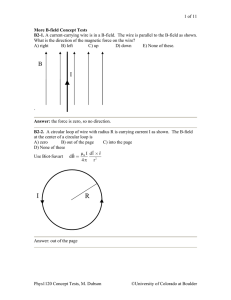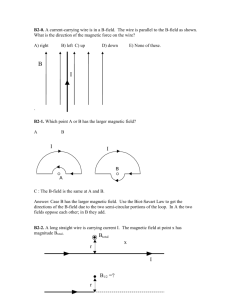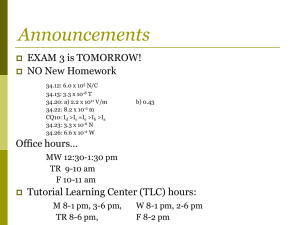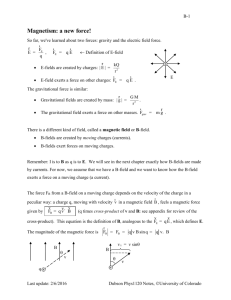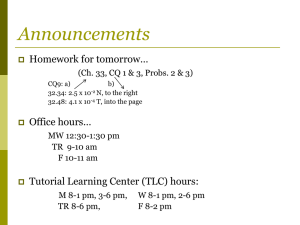Chapter 30 Concept Tests
advertisement
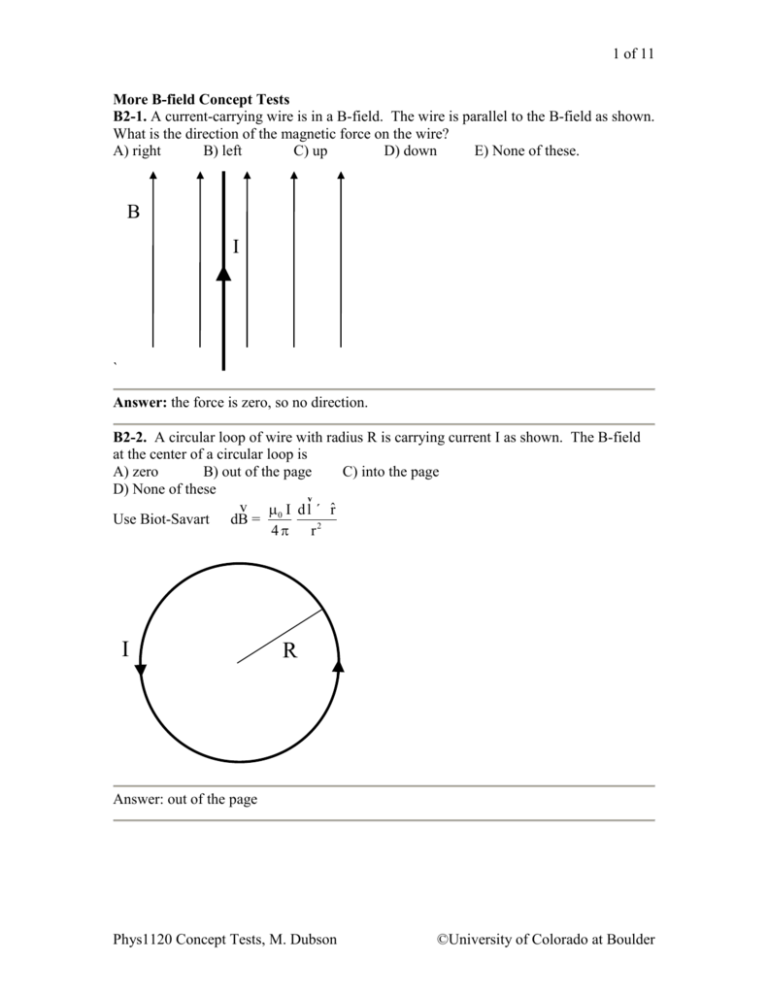
1 of 11 More B-field Concept Tests B2-1. A current-carrying wire is in a B-field. The wire is parallel to the B-field as shown. What is the direction of the magnetic force on the wire? A) right B) left C) up D) down E) None of these. B I ` Answer: the force is zero, so no direction. B2-2. A circular loop of wire with radius R is carrying current I as shown. The B-field at the center of a circular loop is A) zero B) out of the page C) into the page D) None of these v v 0 I d l ´ rˆ Use Biot-Savart dB = 4 r2 I R Answer: out of the page Phys1120 Concept Tests, M. Dubson ©University of Colorado at Boulder 2 of 11 B2-3. Which point A or B has the larger magnetic field? A B C ) The B-field is the same at A and B. I I B A Answer: Case B has the larger magnetic field. Use the Biot-Savart Law to get the directions of the B-field due to the two semi-circular portions of the loop. In A the two fields oppose each other; in B they add. B2-4. A long straight wire is carrying current I. The magnetic field at point x has magnitude Btotal. Btotal x r I B1/2 =? r B True (A) or False (B): The magnetic field 1/ 2 at point x due only to the current to the left of x points in the same direction and has 1/2 the magnitude of Btotal . Phys1120 Concept Tests, M. Dubson ©University of Colorado at Boulder 3 of 11 0 dl r I 2 . The field element dB always points in 4 r the same direction, so the vectors just add like scalars (numbers). Integrating over the left half of the wire gives half the result. z Answer: True. Btot dB z B2-5. 4 parallel wires each carry a current I. 3 of the wires carry current out the page, 1 carries current into the page, as shown. What is the direction of the B-field at the center of the square? y (out) (out) x (in) (out) B) Hint: C) D) E) None of these Answer: Each of the four currents (labeled 1, 2, 3, 4 below) creates a B-field at the cent of the square. The net B-field is the vector sum of these 4 fields and it points to the upper right. y 1(out) 3 2(out) 1 4 x 2 3(out) 4(in) Phys1120 Concept Tests, M. Dubson ©University of Colorado at Boulder 4 of 11 B2-6. A magnetic compass is placed at the points A, B, and C near an electric circuit which has the following twisty shape: A C B The deflection of the compass needle is a measure of the strength of the magnetic field. The relative deflection of the needle in order from biggest to smallest deflection is.. A) ABC D) ACB B) CBA E) None of these. C) BCA Answer: The correct order is CAB. Big currents make big magnetic fields. Near C there are two currents in the same direction which are effectively one big current. Near B, there are two equal currents going in opposite directions, which if they were right on top of each other would give a net current of zero. Point A is the middle case. B2-7. A rectangular loop of wire is carrying a current i in the clockwise direction and is near a long straight wire carrying a current I, as shown. What is the direction of the net force on the rectangular loop, due to the B-field from the long, straight wire. I A i B D C E) Net force is zero. Answer: The net force is up. The B-field due to the long straight wire decreases in Phys1120 Concept Tests, M. Dubson ©University of Colorado at Boulder 5 of 11 oI . So the upward force on 2 r the top of the wire loop F = ILB, is greater than the force on the bottom of the loop. magnitude as you move further from it according to B Another way to see the answer: Parallel currents attract and anti-parallel currents repel. So the upper portion of the loop feels an upward force and the bottom portion of the loop feels a downward force. But the upper portion is closer to the straight wire, so there is a bigger field, a bigger force. B2-8. The (perhaps incorrect) magnetic field lines around an object are partly obscured by a screen. Is this partial field line diagram possible? B A) Yes B) No Answer: Yes. The field lines can be coming in toward the center from above and below behind the screen. This would be the case when two bar magnets have their North poles pointing toward each other. Phys1120 Concept Tests, M. Dubson ©University of Colorado at Boulder 6 of 11 B2-9. The imaginary loop L near a wire with current I has 4 segments labeled 1, 2, 3, and 4, as shown. What is v v B ò ×d l for each of the segments? For 1, 2, 3, 4, the line integral is A) + + 0 – B) 0 + – 0 C) + 0 – 0 D) + 0 + 0 E) None of these 3 1 4 I(in) 2 Answer: + 0 – 0 B2-10. We need a sign convention for I_thru. Place the fingers of your right hand around the imaginary loop and your thumb points in the direction of positive I_thru. What is I_thru here, where all three wires have 5 A? 5A 5A A) +15 A B) –10 A 5A C) +10 A D) –5 A E) None of these Answer: –5 A Phys1120 Concept Tests, M. Dubson ©University of Colorado at Boulder 7 of 11 B2-11. A long straight copper wire has radius b and carries a constant current of magnitude I. The current density of magnitude J=I/(b2) is uniform throughout the wire. What is the current contained in the circular loop £, with radius r < b, centered on the wire's center as shown? 2 ær ö÷ ær ÷ ö ç ç I A) ç ÷ B) ç ÷ I çè b ø÷ çè b ÷ ø b 3 ær ÷ ö ç C) ç ÷ I çè b ÷ ø r D) None of these J = constant How does the magnitude of the B-field a distance r < b from the center of the wire depend on r? A) B r B) B = constant C) B 1/r 2 D) B 1/r E) None of these/don't know. Referring to the same wire, for the new loop £ shown below, what is the value of r r òÑB ×d l ? L A) +0 I/2 B) > 0I/2 b C) < 0I/2 J = constant Phys1120 Concept Tests, M. Dubson ©University of Colorado at Boulder 8 of 11 Answers: F I G Hb JKI . Part 1: Current thru loop of radius r is r 2 Current thru smaller circle = total current I area of smaller circle area of larger circle I r 2 b2 Part 2: Inside the wire, B r. Ampere's Law says r r B òÑ ×d l = mo I t hru , Á ær 2 ö B(2p r) = mo I çç 2 ÷ ÷, çèb ÷ ø or B r µ r 2, B µ r. Outside the wire, we have the standard formula for the B-field outside a wire: B oI 2 r So the field vs. distance from the center of the wire looks like: B B~r B ~ 1/r r b 0 Part 3: Technically the answer is –o I/2 The loop encloses half the current, so by Ampere's Law, Bd o Ienc = o I / 2 . I accidentally chose the sense of the path the wrong way, so the line integral is negative. Phys1120 Concept Tests, M. Dubson ©University of Colorado at Boulder 9 of 11 B2-0b How do the two angles and in the diagram below compare? r dl A) = D) = I x x B) = + 90o E) None of these! C) = Answer: = The sines of these two angles are the same so they make the same contributions in the Biot-Savart law. B2-12. Three long straight solenoids all of length L and all with the same (large) number of closely-packed turns N, all with the same current I, have different cross-sections as shown. A Which solenoid has the largest field B at its center? B D) All three have the same field B. C True(A) or False(B): All three solenoids have uniform B-fields in their interiors. Answers: The field is the same magnitude and uniform for all three solenoids. The field within a solenoid is B = onI. This depends only on the current I and the turns per length n. This formula does not depend on either the cross-sectional shape of the solenoid d or the position within the solenoid. For this formula to apply, one must assume only that the solenoid is very long (has infinite length) and the turns are closely packed (so the current density on the rim is uniform). Phys1120 Concept Tests, M. Dubson ©University of Colorado at Boulder 10 of 11 B2-13. A permanent bar magnet is broken in half. The two pieces are interchanged, keeping their orientations fixed, as shown below. Do the pieces attract or repel? A) Attract B) Repel C) Neither! There is no net force. 2 1 2 1 Answer: They attract. The bar magnet can be thought of as a solenoid of current. Parallel currents attract. When the magnet is broken and rearranged, the currents on the ends are parallel so there is an attraction. In the diagram below, we choose the right end to be North. If we had chosen the right end to be South, all the currents would be reversed, but the end currents would still be parallel. North South South North North 2 1 South South North 2 South North 1 Phys1120 Concept Tests, M. Dubson ©University of Colorado at Boulder 11 of 11 B2-14. A row of positive charges is stationary on the ground. A person with a gaussmeter(which measures the magnetic field) is running to the right along the row of charges, at the same height as the charges and in front of them (in the diagram below). What is the direction of the B-field which the observer measures? + + + + + + Pink(up) + Blue (backward direction) Yellow (forward direction) Green(down) Purple: Zero Answer: From the person's point of view, the person's reference frame, the person is at rest and the (+) charges are moving to the left, so there is a current to the left. The Bfield produced at the person's position is up. I Phys1120 Concept Tests, M. Dubson ©University of Colorado at Boulder
